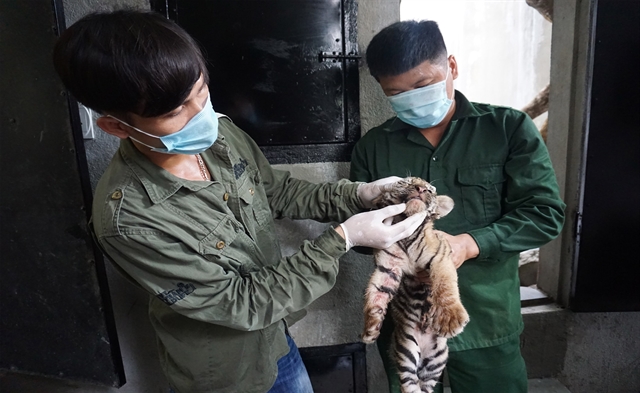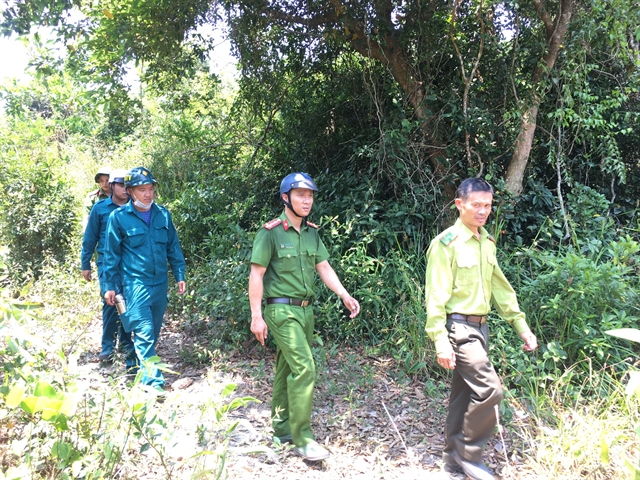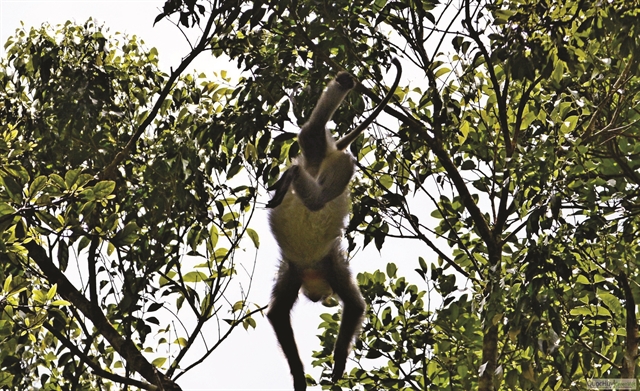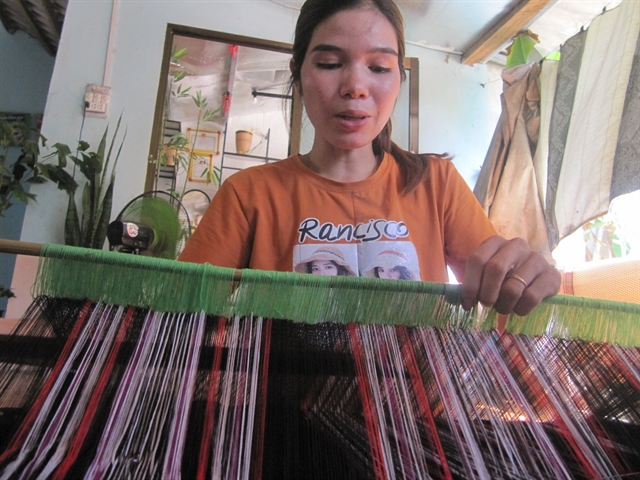 Environment
Environment

 |
| GOOD MOTHERING: A mother grey-shanked douc langur with a baby under her chest moves among trees in a forest in Quảng Ngãi Province. — Photo courtesy of Quảng Ngãi forest protection sub-department |
By Công Thành
A biodiversity conservation project on a 46,000ha primary forest area is under way in Ba Tơ District – home to 169 grey-shanked douc langurs (Pygathrix cinerea), the primate species that is critically endangered, to build the first-ever natural reserve in the south central province of Quảng Ngãi.
The figures were secured in two surveys in the area implemented by Fauna & Flora International (FFI), the Centre for Conservation and Research (GreenViet), and local rangers.
Local authorities and ethnic groups living in six mountainous communes of Ba Tiên, Ba Vì, Ba Tô, Ba Xa, Ba Nam and Ba Lế of Ba Tơ District – 70km west of Quảng Ngãi City – have been struggling with conservation in the last and natural-remaining forest area, aiming to save the primates from extinction and ensure a ‘green lung' in the province.
 |
| FOREST PATROL: Local residents and rangers are on a joint patrol in a forest west of Ba Tơ District. — Photo courtesy of Thế Anh |
Quảng Ngãi is one of five provinces in Central Việt Nam – including Bình Định, Gia Lai, Kon Tum, and Quảng Nam – where about 1,000 endangered primates are reported living in the last well-protected forest, according to Hà Thăng Long, a doctor in biodiversity.
The primary forest area west of Ba Tơ District naturally links with the other protective forests and reserves in neighbouring Bình Định and Gia Lai provinces in creating a great corridor in the world biosphere reserve, Long said.
“It’s an advantage for Quảng Ngãi as having the only rich biodiversity primary forest to promote its value in a wider ‘green’ connection with other biodiversity conservation centres in Central Việt Nam,” he said.
“While the 413,000ha Kon Hà Nừng Plateau in Gia Lai was recognised as the world biosphere reserve by UNESCO in 2021, the 46,000ha primary forest area in Quảng Ngãi could easily integrate its untouched nature into biosphere reserve via the An Toàn nature reserve in Bình Định.”
 |
| MONKEYING AROUND: A grey-shanked douc langur is bouncing on trees in a forest of Ba Tơ District in Quảng Ngãi Province. The forest area has been developing as a nature reserve. Photo courtesy of Quảng Ngãi Forest Protection Sub-department |
'Typical sample of biodiversity'
Dr Long, also a leading langur researcher in Việt Nam, said the primary forest area in western Ba Tơ should be urgently promoted as a nature reserve in line with other neighbouring reserves in creating a larger unique inter-provincial biosphere reserve.
Ngô Vĩnh Phong, deputy head of the sub-department of the Quảng Ngãi provincial forest protection authority, said the local forest protection force had made all efforts to strongly protect the forest area from being badly affected by a local hydropower plant for many years.
“We do all we can to maintain the natural existence of the forest and the population of the grey-shanked douc langurs as well as the richest biodiversity area in the province. The conservation of the flora and fauna of the forest means the next generations can benefit from the prosperity that Mother Earth brings to these reserves,” Phong said.
“The protective forest in western Ba Tơ is a typical sample of biodiversity value in Central Việt Nam and could create a complex of the most important protective primary forest area, stretching three provinces – Quảng Ngãi, Bình Định and Gia Lai – emerging as a new provincial transborder nature reserve at the global level.”
 |
| WEAVING HOPE: A H'Re ethnic woman weaves brocade on a handloom at home in Ba Tơ District of Quảng Ngãi Province. Community-based tourism and canopy farming are possible solutions for local ethnic groups to improve living standards. VNS Photo Công Thành |
Phong said the linkage would be between the Ba Tơ protective forest area and the An Toàn reserve in Bình Định, and the Kon Chư Răng nature reserve and Kon Ka Kinh National Park in Gia Lai.
He said it would be put on the map of conservation sites of the largest population of the grey-shanked douc langurs in Central Việt Nam, as well as having global status.
“Ethnic groups have improved their awareness of illegal hunting and logging, and they acknowledge the importance of forest conservation for longer use rather than immediate over-exploitation. But the problem is how to increase income for the local communities from conservation activities.”
Thế Anh, a member of the Quảng Ngãi provincial sub-department of forest protection
A report from the provincial sub-department of forest protection, shows that Ba Tơ forests record 1,278 flora and fauna species, of which eight are recognised as critically endangered and 45 endangered species including grey-shanked douc langurs, yellow-cheeked gibbon (Nomascus gabriellae), Edwards's pheasant (Lophura edwardsi), giant muntjac (Muntiacus vuquangensis), and Sunda pangolin (Manis javanica).
The report says that two frog species – Odorrana andersonii and the Tonkin Asian frog (Quasipaa delacouri) – are hunted for daily food by the H’Re ethnic group, a major community in Ba Tơ, and local rangers have been working with the community for conservation of the frog species.
Sustainable forest exploitation
Phong said the district has a population of 56,000, of which 46,000 are H’Re ethnics, who live from agroforestry, but 67 per cent of them are impoverished.
“The promotion of the natural reserve for the forest area west of Ba Tơ District would create a huge benefit and long-term goals in terms of unique biodiversity, culture, tourism, income and carbon credit exchange,” Phong said.
“The joint-patrol among the rangers and local residents, which has been seen as the most effective in forest protection, offers sustainable exploitation of the forest for ethnic groups rather than just illegal hunting and logging."
Thế Anh, a member of the Quảng Ngãi provincial sub-department of forest protection, said: “Ethnic groups have improved their awareness of illegal hunting and logging, and they acknowledge the importance of forest conservation for longer use rather than immediate over-exploitation. But the problem is how to increase income for the local communities from conservation activities.”
 |
| GREEN ROOF: Ba Tơ forests are home to 45 endangered species including greyshanked douc langurs. Photo courtesy of Quảng Ngãi forest protection sub-department |
“Community-based tourism, canopy farming and biodiversity research tours are possible solutions for the ethnic groups, who are gradually changing from acacia farming to more profitable afforestation.”
A centre of hand-loom weaving of the H’Re in Làng Teng Village in Ba Tơ has been established as a base of the community-based tourism service since the craft was recognised as a national intangible heritage in 2019.
Dr Long said the introduction of the nature reserve in the area would create 'safe' corridors and habitat for wildlife and primate species moving from forest in Quảng Ngãi to Gia Lai, while helping the inter-provincial network of biodiversity and expanding conservation projects by building a new world biosphere reserve for the wider region. VNS




